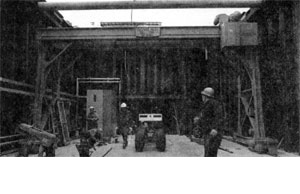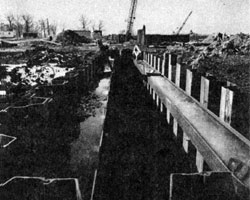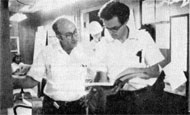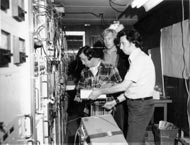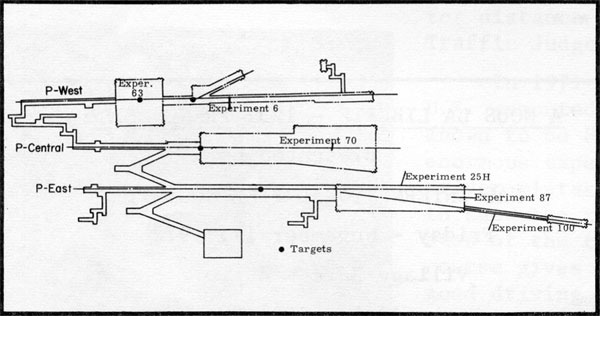Proton Area Begins Study of High Energy Protons
The scientific sleuths who observe the puzzling behavior of the subatomic particles in a proton beam are setting up some intricate equipment in NAL's Proton Area which they hope will soon take some of the mystery out of these remote aspects of physical matter. Seen from the air, the corridors of the Proton Area are a huge, gaping labyrinth - rectangular pits typically 25 feet wide, 20 feet in depth, walled by massively-corrugated sheet steel pilings, woven into a where-does-it-end? pattern. Seen from the ground, the stark plainness of the structures and the intricate paths of the beam lines reveal that the people who worked here were preparing for something unusual in the way of particle reactions.
On November 3, 1972 a beam of 200 BeV protons was steered out of the main accelerator, through the switchyard, and cleanly down the proton experimental line which is the east-most line of the three-pronged external experimental switchyard. Focussing on a tungsten target 1/8" in diameter, that first beam was seen in the P-Central area. Within 50 feet on either side are P-West and P-East, the other two places where experimental work was carried on.
In addition to bringing the line into operation, the event also represented the complete activation of the NAL experimental areas - the Meson and Neutrino lines having previously come on the air in the past few months.
In the Proton Area, experimenters study the collisions on targets of protons which come directly from the accelerator - in contrast to the other NAL experimental areas which study secondary beams - that is, beams of particles which are first produced from collisions on targets in the particular area, then transported for study. Experiment Number 70, for instance, has already begun in the Proton Area. It is a collaboration of Columbia University, Rockefeller University, and NAL experimenters to be carried out in three phases - measurements of the production of (1) gamma rays; (2) electrons, and (3) pairs of electrons and positrons. The numbers of these particles produced as the proton beam strikes targets and the energies carried off by the new particles will be measured at a variety of angles. Data will be closely scrutinized for possible existence of exotic new particles suggested in recent years, such as the W "intermediate weak boson" or Bo "heavy photon." Five other experiments are to be housed in the Proton Area in this first wave of experimenting there, all searching for new phenomena.
Physicist Lincoln Read has directed the development of the Proton Area in the last several months. Many of the conceptual ideas for the design originated with Al Maschke. "The backbone of our effort has been the determined work of a small group of people who have been working on this project since last February," according to Dr. Read. "This includes Ron Currier, Dave Eartly, Dean Lee, Alice Lengvenis, Bob Scherr and Ed Tilles. During the intervening months, many others have entered the fray - Jesse Guerra, Al Guthke, Bettie Howe, Frank Juravic, Del Hoffman, Ed LaVallie, Tom Nash, Lou Nouzak of Technical Services, Stan Orr, John Peoples, Bob Shovan, Larry Tate, and Aage Visser.
"They have all contributed enthusiastically toward getting Proton Central operational. Everyone is now working very hard toward achieving a second important milestone in the Proton Area - the start of beam operations in Proton East, which we hope to achieve in December. Early next year. Experiment Number 100 (in Proton East), which is being done by physicists from Princeton University and the University of Chicago, can then begin.
"The people in the Proton Section are only partly responsible for the fact that the Proton Area is now coming into operation for experiments," Read said. "Our appreciation goes to all the other groups at NAL and DUSAF whose help and cooperation has been enormously important."



